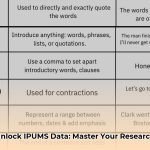Understanding Classification
Ever feel overwhelmed by the sheer amount of stuff in your life? From overflowing inboxes to chaotic closets, the ability to classify – to organize items into logical groups – is a fundamental skill. This guide provides a practical, step-by-step approach to classifying anything, from your sock drawer to complex datasets.
What is Classification?
Classification is simply the process of grouping similar items together. Think of it like organizing your kitchen utensils: forks with forks, knives with knives. This makes them easier to find and use. The same principle applies to information: organizing data makes it simpler to understand, analyze, and use effectively.
Methods of Classification
There isn’t one “right” way to classify. The best approach depends on what you’re organizing and why. Let’s explore some common methods:
Hierarchical Classification
Imagine a family tree for information. This method uses a top-down structure, starting with broad categories and branching down to more specific ones. Think of the animal kingdom: Animal -> Mammal -> Primate -> Human.
- Example: Organizing a company’s organizational chart.
Taxonomy
This is hierarchical classification’s more scientific cousin, often used in fields like biology. It focuses on precise naming and defining of groups.
- Example: Classifying newly discovered plant species.
Folksonomy
A democratic approach where users define the categories. Think of tagging photos on social media.
- Example: Tagging pictures on Instagram.
Faceted Classification
Categorizing items based on multiple characteristics. This is how online shopping filters work (size, color, brand).
- Example: Filtering products on Amazon.
Data Classification
Used to categorize data for analysis, machine learning, or security.
- Example: A spam filter classifying emails.
| Method | Description | Example |
|---|---|---|
| Hierarchical | Tree-like structure | Company organizational chart |
| Taxonomy | Scientific classification | Plant species |
| Folksonomy | User-generated categories | Social media tags |
| Faceted | Multiple attributes | E-commerce filters |
| Data Classification | Data analysis/security | Spam filter |
A Step-by-Step Guide to Classifying Anything
1. Define Your Goal
What are you trying to achieve? Are you organizing for analysis, retrieval, or simplification? Knowing your “why” is crucial.
2. Identify Your Items
What are you classifying? Books? Data? Ideas? Clearly define the scope of your project.
3. Establish Your Criteria
What characteristics will you use to group items? Color? Size? Function? Choose criteria relevant to your goal.
4. Create Your Categories
Develop distinct, non-overlapping categories based on your chosen criteria. Clear definitions are essential.
5. Assign Items to Categories
Place each item into the most appropriate category. Some judgment calls may be necessary. Don’t be afraid to revisit your criteria if needed.
6. Review and Refine
No system is perfect from the start. Test your classification, identify any gaps or overlaps, and adjust as needed. Classification is an iterative process.
Real-World Applications
Classification is everywhere. Librarians use the Dewey Decimal System to organize books. Governments use security classifications (Top Secret, Confidential) to protect information. Businesses use data classification to analyze customer behavior and personalize marketing. Even sorting your email relies on classification principles.
| System | Purpose | Structure | Example |
|---|---|---|---|
| Dewey Decimal System | Library organization | Numerical | 005.133 (Python Programming) |
| Security Classification | Data protection | Levels | Top Secret, Confidential |
Advanced Techniques: Hierarchical Classification in Depth
Hierarchical classification, with its tree-like structure, offers advantages for complex data. But choosing the right hierarchical approach is essential.
Different Hierarchical Approaches
- Flat Classification (Top-Down): Directly predicts the most specific category, ignoring the hierarchy. Suitable for simple datasets, but inefficient for complex ones.
- Local Classifiers: Uses multiple classifiers, either at each node or level of the hierarchy. More precise but potentially resource-intensive.
- Global Classifiers: A single classifier for the entire hierarchy. Efficient but can be difficult to train effectively.
Key Considerations
- Taxonomy vs. Ontology: Taxonomies group based on shared characteristics. Ontologies define relationships and properties, offering a richer understanding.
- Static vs. Dynamic Hierarchies: Static hierarchies are fixed. Dynamic hierarchies adapt and evolve based on new information.
Applications
Hierarchical classification is widely used in:
- Data Mining: Uncovering hidden patterns in large datasets.
- Image Recognition: Identifying specific details, like dog breeds.
- Text Classification: Organizing documents into topics and subtopics.
- Recommender Systems: Providing personalized suggestions.
Choosing the Right Method
Choosing the best classification method is a balancing act. Consider these factors:
- Data Complexity: How intricate are the relationships between your items?
- Number of Categories: A large number of categories may require a more sophisticated approach.
- Computational Resources: Some methods are more resource-intensive than others.
| Method | Advantages | Disadvantages |
|---|---|---|
| Flat Classification | Simple | Inefficient for complex data |
| Local Classifiers | Precise | Resource-intensive |
| Global Classifiers | Efficient | Difficult to train |
There’s no one-size-fits-all solution. Experimentation and careful evaluation are crucial for finding the optimal approach. Remember that the field of classification is constantly evolving, so stay curious and explore the latest research. With the right approach, you can transform chaos into order and unlock the power of organized information.
- How Much Do Wellness Programs Cost Businesses To Offer? - December 16, 2025
- Wellness Fair Ideas for Work to Boost Employee Wellbeing - December 15, 2025
- Affordable Employee Wellness Fair Ideas for Any Budget - December 14, 2025
















